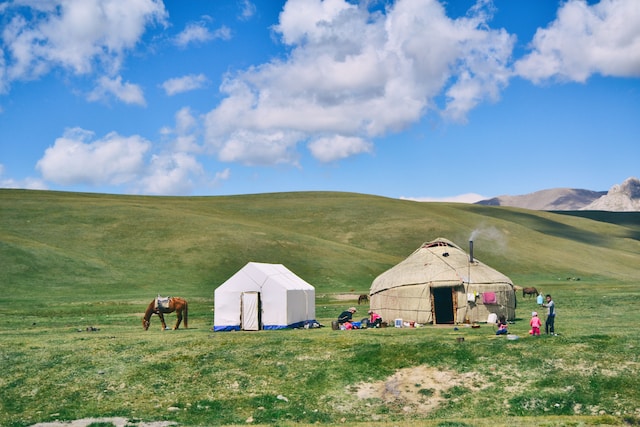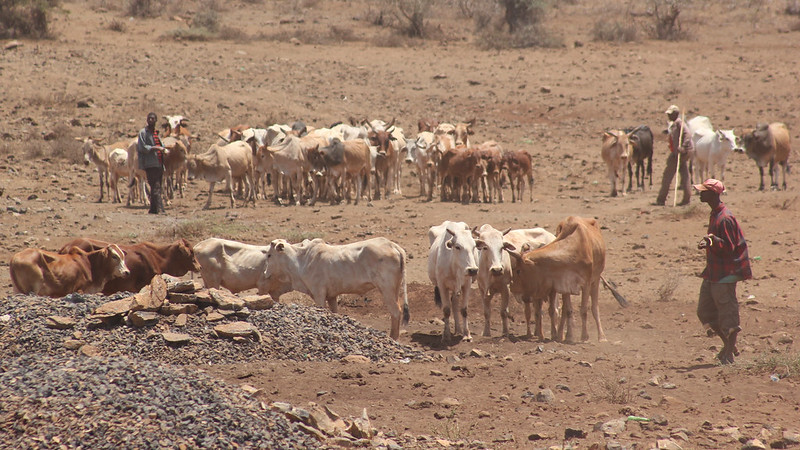Nomads are more focused on mobility and gathering resources from the land as they move around, while pastoralists are centered around raising livestock for sustenance. Nomadic life allows for greater adaptability to environmental changes but can also result in a lack of stability and security. On the other hand, pastoralism provides a more consistent source of food but requires a stable source of water and grazing land.
What are nomads?
(Photo by Oziel Gómez on Unsplash )

Nomads are people who do not have a permanent home and instead move from place to place in search of food, water, and shelter. They travel with their families and belongings, often using pack animals such as camels or horses to transport their possessions. Nomadic societies can be found all over the world, from the deserts of North Africa to the grasslands of Mongolia.
One characteristic that sets nomads apart is their flexibility. Because they must constantly adapt to changing conditions in their environment, nomads have developed resourceful ways of providing for themselves. For example, some groups rely on hunting and gathering wild plants for sustenance; others herd livestock such as goats or cows.
Despite these challenges, many nomads enjoy a strong sense of community and connection to nature. Living close to the land allows them to develop an intimate knowledge of local ecosystems and weather patterns. Some even view movement itself as a spiritual practice that keeps them attuned to the natural rhythms of life.
In recent years, however, many traditional nomadic lifestyles have come under threat due to factors such as climate change, land use policies favoring settled agriculture over herding practices,and rapid urbanization . Despite these challenges though , there remains a small but resilient population who continue practicing this way o f life today
What are pastoralists?
(Photo By Kandukuru Nagarjun on Flickr)

Pastoralists are a group of people who rely on the herding of domesticated animals for their livelihood. Unlike nomads, pastoralists have permanent homes and live in one location year-round. However, they move their animals from place to place in search of fresh pastures.
Pastoralism has been practiced around the world for thousands of years, with different cultures developing unique techniques and traditions. For example, some pastoralist societies practice transhumance – where they move their livestock between lowland and highland pastures seasonally.
One benefit of pastoralism is that it provides a sustainable way of living off the land without relying on agriculture or industry. Pastoralists can use animal manure to fertilize crops, and they can sell meat, milk, wool or other products derived from their herds.
However, there are also challenges associated with pastoralism such as overgrazing which causes soil degradation leading to desertification. Climate change also disrupts traditional grazing patterns by changing weather conditions making it hard for pastoral communities who depend so much on rainfall patterns.
Despite these challenges faced by pastoral communities worldwide today; many still uphold this lifestyle as an important part of cultural heritage passed down through generations which should be preserved for future generations to come.
Nomads Vs. Pastoralists – Key differences
Nomads and pastoralists are two groups of people who share some similarities in their lifestyle but have some key differences as well. Nomads move from one place to another in search of food, water, and shelter while pastoralists stay in one place and tend to their livestock.
One of the main differences between these two groups is that nomads do not rely solely on livestock for their livelihood. They often hunt wild animals or gather food from nature while moving from one location to another. In contrast, pastoralists depend entirely on their herds for sustenance.
Another significant difference is that nomadic lifestyles require constant movement, which makes it challenging to establish permanent shelters or structures. On the other hand, pastoralism can lead to more stable living conditions as they can build homes and fences around grazing areas.
Nomads tend to be more self-sufficient than pastoralists because they often have a broader knowledge of how to survive off the land without relying on domesticated animals alone. In contrast, pastoralists rely heavily on their herds’ health and productivity for survival.
Although both lifestyles may seem similar at first glance since they involve moving around with animals seeking resources; there are crucial distinctions between them that set them apart.
The benefits of a nomadic lifestyle
Living the life of a nomad is not for everyone. It requires a certain level of resilience, flexibility, and adaptability to thrive in an ever-changing environment. However, there are several benefits to this lifestyle that cannot be ignored.
Firstly, nomads have the freedom to explore new places and experience different cultures. They are not tied down by material possessions or societal norms, allowing them to fully immerse themselves in the world around them.
Another benefit is the ability to live off the land and rely on natural resources for survival. Nomads typically hunt animals, gather wild plants for food and medicine, and use natural materials for shelter and clothing. This connection with nature can lead to a more sustainable way of living compared to modern society’s reliance on technology and consumerism.
Moreover, nomadic lifestyles often promote strong community bonds among individuals who share similar values and goals. The sense of belonging within these communities can provide emotional support during difficult times.
Living as a nomad allows one to develop crucial skills such as problem-solving abilities while navigating unfamiliar environments. Adaptation becomes second nature when you’re constantly moving from place-to-place.
While living as a nomad may seem daunting at first glance due to its inherent challenges it also provides numerous benefits unmatched by any other lifestyle; like cultural immersion experiences & sustainability practices that have been lost over time due consumption-focused societies etc., so it’s no surprise why some people choose this way of life!
The disadvantages of a nomadic lifestyle
A nomadic lifestyle can offer freedom and adventure, but it also comes with its own set of challenges. One disadvantage is the lack of stability. Nomads frequently move from place to place, which can make it difficult to establish long-term relationships or build a sense of community.
Another challenge is access to basic needs such as food, water, and shelter. Nomads often depend on their environment for survival and must constantly search for resources as they travel. This can be especially challenging in harsh climates or areas with limited resources.
Healthcare can also be an issue for nomads who may not have access to medical facilities or healthcare providers while on the move. Injuries or illnesses that require specialized care could potentially become life-threatening if left untreated.
Education is another concern for nomadic families with children. Moving frequently makes it difficult for children to maintain consistent schooling, which could limit their opportunities later in life.
There’s the emotional toll that constant movement can take on individuals and families alike. The stress of packing up everything you own every few months and moving again can wear down even the most resilient person over time.
What is the difference between pastoralists and farmers?
Pastoralists and farmers are both involved in the production of food, but they have different practices when it comes to raising animals. Pastoralists rely on the care of their livestock for survival, while farmers focus on cultivating crops.
Pastoralists typically move from place to place with their herds, searching for fresh grazing land. They herd cattle, sheep, goats or camels and often sell them as a source of income. On the other hand, farmers own land where they grow crops such as wheat or corn throughout a whole year.
Another difference is that pastoralism requires less investment in infrastructure than farming. Pastoralists don’t need to build permanent structures or irrigation systems since they move around frequently. Farmers usually invest heavily in machinery and equipment that will last for years.
While both pastoralism and agriculture have been practiced for thousands of years, today’s society tends to favor farming over pastoralism due to concerns about sustainability and animal welfare.
There are several key differences between pastoralists and farmers regarding how they produce food. Both practices play important roles in our global economy but have different approaches towards it.
Who were the first nomads?
The origin of nomads can be traced back to prehistoric times, where humans used to wander in search of food and shelter. These early nomads were hunters and gatherers who followed the herds of wild animals they hunted for their sustenance.
As time passed, the invention of agriculture led to a sedentary lifestyle, but some groups still followed a nomadic way of life. Nomadic cultures developed all over the world, from the Arctic tundra to deserts and rainforests.
One example is the Bedouins, who live in arid regions such as North Africa and the Middle East. They have been leading a nomadic lifestyle for thousands of years, raising camels and goats for milk, meat and transportation across vast distances.
Another example is Mongolian nomads who have lived on horseback as pastoralists since ancient times. They roam freely with their livestock across Mongolia’s vast steppes looking for fresh pastureland.
Nomadism has always been an essential part of human history as it allowed people to adapt quickly to changing environments by moving around rather than settling permanently in one place.
Featured Image By – Patrick Schneider on Unsplash








